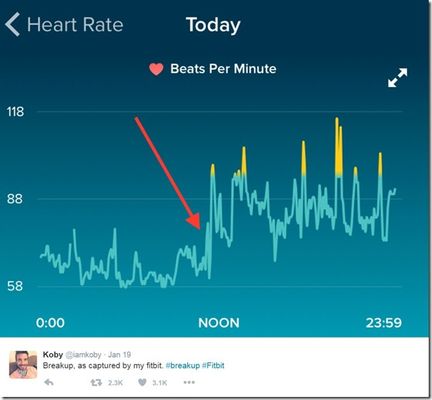emotions
1 TopicWearing Emotions on Your Sleeve...Literally
Imagine if your emotions and feelings could be measured, tracked and included in a data graph. I'm sure you've heard the saying 'wearing your heart on your sleeve' to indicate that someone expresses their emotions freely or exposes their true emotions without caution. This can be good in that you become open and vulnerable when showing your true feelings but can jade areas like composure in situations where you might be frustrated or irritated. I tend to be fairly open with my emotions. There are a few stories about the origin of the saying going back to the Middle Ages. Emperor Claudius II felt unattached men make better warriors so he outlawed marriage. To alleviate some of the grievances, every year during the Roman festival honoring Juno, he'd allow temporary coupling where men drew names to determine who would be their lady friend for the year. The man would wear her name on his sleeve for the festival. Around the same time, when knights performed jousting matches, they'd dedicate their match to a lovely lady of the court. By wearing her hanky around his arm, he was signaling that he was defending her honor. And in Shakespeare's Othello, Iago confesses, For when my outward action doth demonstrate The native act and figure of my heart In complement extern, ’tis not long after But I will wear my heart upon my sleeve For daws to peck at. I am not what I am. – Othello, Act 1, Scene 1, 61–65 Whatever the origin, humans are emotional creatures. We typically make choices based on emotion, even though we'd like to think it was a rational decision. We may try to hide our emotions as to not upset or reveal something to another person. Often called a Poker Face. But imagine if your emotions and feelings could be measured, tracked and included in a data graph. Other than a polygraph. Daydream no more. There are now wearables that track your emotions. This is not your father's old-skool mood ring but devices that read your current emotional state and attempts to sooth and lower stress levels by encouraging deep breaths and relaxation techniques to get you through the haze. Sensors that gather skin temperature, sweat gland activity and blood pulse along with movement gauge your activity level. From that, it generates a graph on your mobile phone so you can see when your stress levels peaked and the mood at the time. You can see real time or over the course of the day. Emotional analysis in your pocket...or sleeve if you got one of those runner's arm band things. I'm sure someone will create a shirt that has color changing sleeve threads depending on a person's emotional state. The Iagonaut. This is not the future but today. A Fitbit captured the moment of a broken heart during a relationship ending phone call. This man was wearing his Fitbit when the unexpected call came and his daily graph tells the whole story: Koby (@iamkoby) shared his heart wrenching moment (and graph) on Twitter and it saturated the internet. The red arrow indicates the moment that the news hit him. Instantly, his heart rate jumped from 72 to 88 beats per minute and stayed high for the rest of the day. Clearly this healthy, athletic person was under duress and if you couldn't tell by the yellow peak marks, he had trouble sleeping that night. Talk about exposing your emotions with technology. Would you share your sleeve with the world? ps Related: Fitbit captures exact moment man's heart breaks The Origins of Wearing Your Heart on Your Sleeve Forget fitness, this wearable tracks your emotions Connecting the Threads The Digital Dress Code Wearables Head to Tail Gartner Says Worldwide Wearable Devices Sales to Grow 18.4 Percent in 2016 Technorati Tags: iot,wearables,emotions,humans,stress,sensors,silva,f5 Connect with Peter: Connect with F5:1.4KViews0likes0Comments
